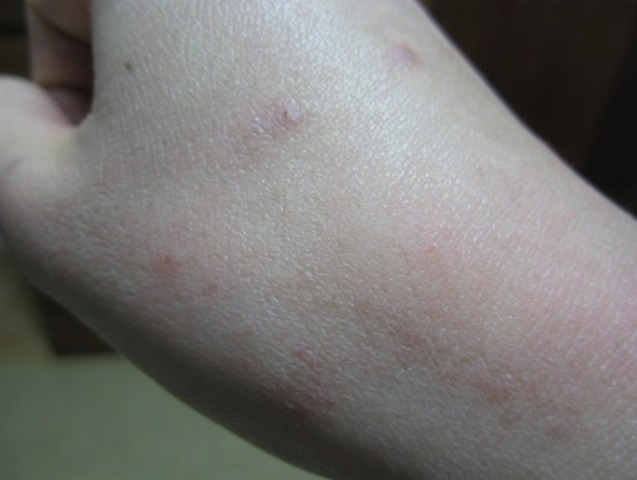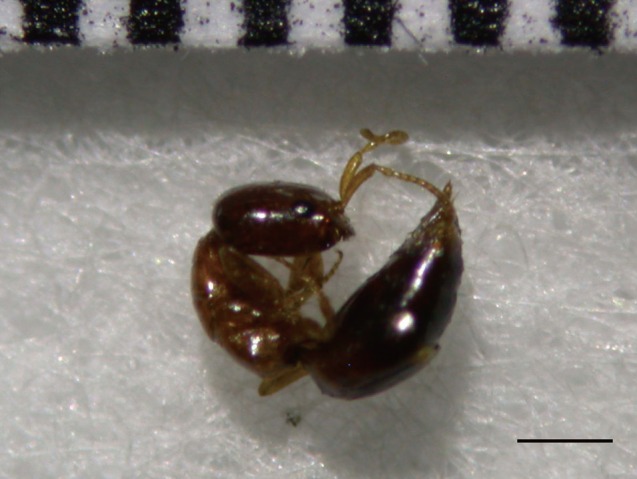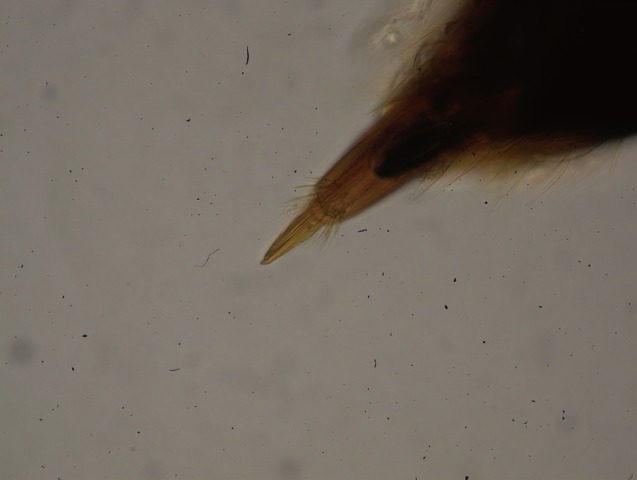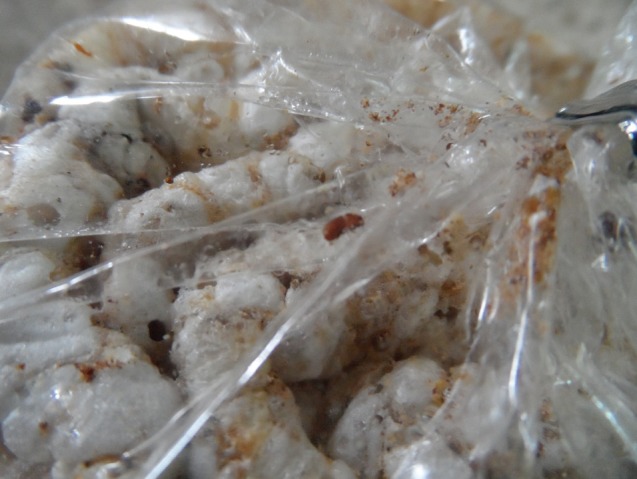Human Sting of Cephalonomia gallicola (Hymenoptera: Bethylidae) in Korea
Article information
Abstract
Hymenoptera stings can cause serious injury to humans. We report the clinical findings of 6 cases of Hymenoptera stings. All patients developed painful erythematous papules at the sting sites and had a past history of parasitoid wasp sting. This is the first clinical report of the parasitoid wasp, Cephalonomia gallicola, causing human stings in Korea.
INTRODUCTION
Hymenoptera are one of the medically most important insects. The stings of Hymenoptera, including Apoidea (bees), Vespoidea (wasps, hornets, and yellow jackets), and Formicidae (poneromorph ants), account for the majority of severe allergic reactions to insects [1]. Many of the Hymenoptera are parasitoids. The Bethylidae is a family of Hymenoptera that consist of approximately 82 genera and 2,200 species worldwide have evolved to exploit coleopteran and lepidopteran larvae and pupae, and are often found in cryptic locales such as soil, leaf litter, wood, stems, and seeds.
Cephalonomia gallicola (Bethylidae) is a gregarious external parasitoid of the larvae and pupae of the cigarette beetle, Lasioderma serricorne (Coleoptera: Anobiidae), which is an injurious pest to stored dried products, other animals and vegetable materials [2]. The Bethylidae is one of the most powerful epizoic parasitoid wasps and contains anesthetic compounds, which cause painful irritation at the site of the sting. Human stings by Bethylidae, a parasitic wasp, have been reported in Europe and North America [3], Japan [4], and New Zealand [5]. In such cases, Cephalonomia, Goniozus, and Sclerodermus species were involved. Those species should be considered as a cause of allergic responses in patients living in houses with visual evidence of parasitoid wasp infestation. To date, there have been no clinical reported investigations on parasitoid wasp stings in Korea. We describe here the clinical findings of 6 cases of C. gallicola sting detected in 2013.
CASE RECORD
The patients (Table 1) visited the Arthropods of Medical Importance Resource Bank, and were referred to Yonsei University Severance Hospital (Seoul, Korea) because of multiple insect sting markings.
Case 1 was a 39-year-old female with severe pain at the sting sites and had erythematous papules over her hand (Fig. 1). She had no significant abnormalities of the cardiovascular, respiratory, nervous, or gastrointestinal systems. She observed insects in the bedroom of her home and suspected that they were the cause of her complaints. She brought in an insect that had been caught in her bedroom. On examination, the insect was identified to be a female C. gallicola (Figs. 2, 3). Casts of C. gallicola were found in the food storage room of her home (Fig. 4).

Erythematous papules with central punctums on the hand of a patient, caused by Cephalonomia gallicola.
Case 2 was a 35-year-old male with generalized sting marks over his right arm. He was treated with oral antibiotics, oral antihistamines, and topical corticosteroid cream by a physician at private clinic, resulting in an improvement of local symptoms. He did not have any significant problems immediately after being stung, except for local swelling and itching at the sting sites. He also brought in an insect that had been caught in the living room of his home. On examination, the insect was identified to be a female C. gallicola.
Case 3 was a 42-year-old female with severe pain at the sting sites and erythematous papules over her abdomen. She had no significant abnormalities in any other organ. She brought in an insect that had been caught in the bedroom of her home. On examination, the insect was also identified to be a female C. gallicola.
Case 4 was a 31-year-old female with severe pain at the sting sites and erythematous papules over her left leg. She also brought an insect that had been caught in her bedroom. On examination, the insect was identified to be a female C. gallicola.
Case 5 was a 51-year-old male with swelling and itching at the sting sites and generalized sting marks over his abdomen. He also brought in insects from his bedroom. On examination, the insects were identified to be female C. gallicola. His lesions disappeared 1 week after the discovery of the insects without medical treatment of antihistamines or corticosteroids.
Case 6 was a 3-year-old male with signs of redness, swelling, and pain at the sting sites. His father suspected the presence of insects in the boy's bedroom. Three captured specimens were submitted to us for identification and were all found to be female C. gallicola. He was treated with topical corticosteroid cream resulting in the subsidence of local symptoms.
Measurements of 16 C. gallicola females were obtained from observing the specimens with a microscope equipped with a micrometer. C. gallicola while monomorphic, do vary slightly in length and are approximately 1.98 mm to 2.59 mm long (average 2.23 mm) (Table 1). Body usually rounded and brown entirely. Antennae well developed and 12 segmented. Thorax with pronotum bell-shaped. Abdominal segments well developed and postabdomen with a diminutive sting (Figs. 2, 3).
Antihistamines and/or corticosteroids were given to all patients and the signs and symptoms in all patients improved within 2 weeks. Disinfestation of the patients' houses was performed using treatment with commercial insecticide (0.5% permethrin) in all rooms of the house, keeping it sealed. Three days after the insecticide treatment, an investigation was performed to confirm the elimination of insects from the house, and no parasitoid wasp, C. gallicola, has been found to date.
DISCUSSION
Hymenoptera sting is a major clinical problem. Hymenoptera venoms contain many pharmacologically active constituents, including histamine, serotonin, acetylcholine, dopamine, noradrenaline, melittin hyaluronidase, apamin, and phospholipase [1]. The typical human sting reactions include headache, giddiness, nausea, pain at the sting sites, shortness of breath, and anaphylactic responses.
The parasitoid wasp, C. gallicola, has a diminutive stinger and stings if it is irritated. Stings from C. gallicola causes medical problem. In our case, C. gallicola sting was associated with indoor activities. Probably, the females were searching for larval forms of Coleoptera in household. The stings were inflicted on the hands, arms, legs, and abdomen. In case of skin lesions, exhibited redness, swelling, and pain at the sting sites, with the development of pruritic erythematous papules, similar to other arthropod bites and stings. C. gallicola wasp most frequently sting humans during the spring (May) and summer (June-August), though the pattern depends on parasitoid wasp activity in nature.
The parasitoid wasp fauna of Korea, C. gallicola [2], Sclerodermus harmandi [6], and 5 species of Goniozus, including G. koreanus, G. mesolevis, G. akitsushimanus, G. yoshikawai, and G. maurus [7], have been documented. Goniozus and S. harmandi are found mainly in the outdoor environment, while C. gallicola is found indoors. C. gallicola coexist with Pachycondyla chinensis in the indoor environment in Korea. C. gallicola are very similar to P. chinensis morphologically and the 2 are very difficult to distinguish. C. gallicola is a wasp and P. chinensis is an ant. P. chinensis was reported to be the only ant sting in the home environment. These stinging ants included a total of 12 species in 6 genera of the poneromorph group in Korea [8]. Anaphylactic reactions were occasionally induced by P. chinensis [9,10,11]. An ant sting can cause a wide range of allergic responses in sensitized individuals. The sensitization rate to P. chinensis was found to be 23.0% in residents living in an endemic area, and 2.1% of the residents were reported to have a history of systemic allergic reactions to the ant in Korea [11].
The characteristic morphology of the skin lesion and history are very important in making the diagnosis of Hymenoptera sting. Skin lesions can be similar to various types of dermatitis and other skin pathologies. Diagnosis should be based on the history and physical findings of Hymenoptera sting. The skin lesions caused by C. gallicola, an etiologic diagnosis may be difficult. Confirming the diagnosis of a C. gallicola, sting is sometimes difficult to be suspected unless to obtain a detailed explanation of the home environment.
The clinical diagnosis of C. gallicola sting should take into accounts the many potential reactions to the insect's bite/sting. Further investigations are necessary to examine the possibility of cross sensitization between allergic disorders caused by C. gallicola and P. chinensis.
To the best of our knowledge, this is the first clinical findings report of human stings by the parasitoid wasp, C. gallicola, in Korea.
ACKNOWLEDGMENTS
This study was supported in part by the National Research Foundation of Korea (NRF-2012M3A9B8021806). We thank Prof. Seunghwan Lee, Division of Entomology, Seoul National University, Korea for his kind assistance in the identification of specimens.
Notes
We have no conflict of interest related to this study.



